| Home | Nature Weekly Index |
2 March 2025 | Plant Pests | Soft Bugs |
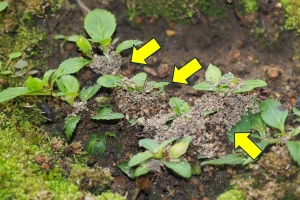 |
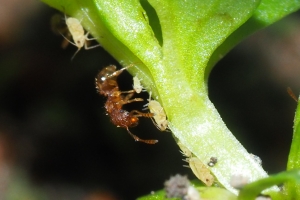 |
| Fig. 1: Mecardonia procumbens partially buried in sand | Fig. 2: Aphids and an ant (Pheidole parva) on the stem of Mecardonia procumbens |
A few days after re-planting the Mecardonia procumbens (Yellow-flowered Waterhyssop) collected on 11 February, I observed that ants began accumulating sand in an effort to bury part of the plant (Fig. 1). To prevent the burial of the plant, I removed the loose sand. However, the following day, the ants resumed their activity. This cycle of me removing the sand and the ants refilling it persisted for several days.
In an attempt to understand the reason behind the ants' behaviour, I examined the plant for any clues but initially found none. Typically, such behavior by ants is associated with hiding their food source, which is often plant sap-sucking insects. Upon closer inspection and by reviewing enlarged photographs, my hypothesis was confirmed. Several tiny aphids were indeed present along the stem of the plant (Fig. 2).
Regarding plant pests, they are consistently present in my potted plants. Currently, the undersides of some citrus leaves are infested with whiteflies, appearing as whitish powders. In another pot, a type of scale insect has been infesting the Solanum americanum (American Black Nightshade), which the plant appears to tolerate well so far. Additionally, some mealybugs have been found along the stem of the Leonurus japonicus (Chinese Motherwort). These so-called soft bugs or plant parasites were easily identified due to the movement of ants. As my potted plants are cultivated for observation purposes, I do not typically remove the pests unless they become unmanageable or visually unappealing.
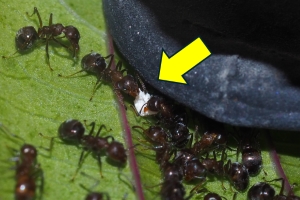 |
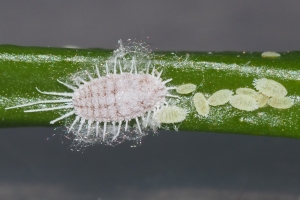 |
| Fig. 3: Cocoa Black Ant attending to a Icerya seychellarum (Yellow Cushion Scale) | Fig. 4: Pseudococcus longispinus (Longtailed Mealy Bug) and its nymphs |
In addition to the usual ants (Pheidole parva) in my pot, the recent proliferation of soft bugs has also attracted the Cocoa Black Ant (Dolichoderus thoracicus) (Fig. 3). While this ant is commonly observed in parks, it seldom enters homes. However, this is not the first occurrence of such an invasion in my potted plants; a similar incident involving this ant occurred in April 2017 for the same reason.
The mealybugs on Leonurus japonicus are likely to be Pseudococcus longispinus (Longtailed Mealy Bug), identifiable by the two long waxy filaments protruding from the last abdominal segment of the adult bugs (Fig. 4). The nymphs closely resemble the adults. On another plant (Leea rubra), a small mealybug, appearing to be the nymph of the Yellow Cushion Scale (Icerya seychellarum), was observed on the back of a leaf near the base of the plant. This nymph has been under the protection of several Cocoa Black Ants for a few days. Subsequently, a larger group of these ants was discovered on the back of another leaf higher up on the plant, where a second Yellow Cushion Scale was also noted.
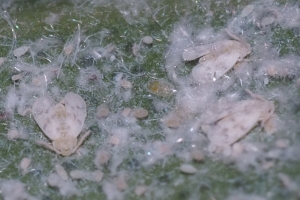 |
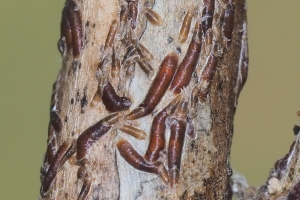 |
| Fig. 5: Paraleyrodes bondari (Bondar's Nesting Whitefly) | Fig. 6: Armoured Scale Insect (probably a Lepidosaphes species) |
I have been attempting to ascertain the identity of the whiteflies infesting the Citrus plant (Fig. 5). Based on images from two publications from India [1-2], I currently identify them as Paraleyrodes bondari (Bondar's Nesting Whitefly). These publications describe an "X"-shaped marking on the adult forewing, which corresponds with my observations.
In February 2017, there was a significant whitefly infestation on my Sweet Leaf Bush (Breynia androgyna). This species is likely Trialeurodes vaporariorum (Glasshouse Whitefly), as indicated by the Plant Pest Factsheet by the Department of Environment, Food, and Rural Affairs in the United Kingdom. The factsheet notes that this whitefly's eggs are laid in partial circles and possess a greyish hue.
Another potential candidate for this whitefly species is Bemisia tabaci (commonly known as Silverleaf Whitefly or Sweet Potato Whitefly), which can coexist with the Greenhouse Whitefly on the same host plant.
The scale insects observed carpeting the stem of Solanum americanum appear to be an Armoured Scale Insect, likely a Lepidosaphes species (Fig. 6).
References:
[1] Sadhana V, Senguttuvan K, Murugan M, Manikanda BN, Sathiah N. First record of Bondar's nesting whitefly, Paraleyrodes bondari Peracchi (Hemiptera: Aleyrodidae), occurrence and infestation in the cotton ecosystem of Tamil Nadu, India. The Pharma Innovation Journal 2021;SP-10(10):1278-1284. | Read article |
[2] Suriya S, Sadhana V, Madhanram G, Vengatesh KM, Maheshwari S. Bondar's nesting whitefly, Paraleyrodes bondari Peracchi - A threat to coconut ecosystems. Farm Chronicle 2025;4(0):13-15. | Read article |